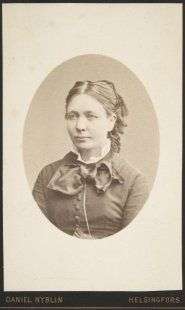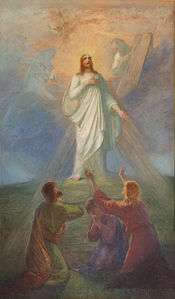Alexandra Frosterus-Såltin
Alexandra Theodora Frosterus-Såltin (6 December 1837, Ingå – 29 February 1916, Vaasa) was a Swedish-Finnish painter and illustrator who is best known for her altarpieces.

Photograph by Daniel Nyblin
Biography
Her father, Benjamin, was a theology professor and her mother, Vilhelmina, was Finland's first female graduate student. Her mother died when he was seven, and her father remarried in 1846. Most of her childhood was spent in Vaasa, where her father was a church official. At the age of fourteen, she left home to become a private student of Robert Wilhelm Ekman in Turku, and studied with him for five years.[1]

In 1858, on Ekman's recommendation, she was asked to provide drawings for a publication of the Raittiuden Seuran (temperance society); an anti-alcohol booklet called Turmiolan Tommin Elämäkerta (The Life Story of Pernicious Tommy). Her drawings were engraved by F.O. Liewendahl (fl.1850s-1860s) and the booklet was reissued for many years.[2] The story itself (by an unknown writer) came to be referenced in several popular songs; as recently as 1982 by the Finnish rock band Eppu Normaali.
Later in 1858, she held her first exhibition of serious works at the Finnish Art Society and received a scholarship.[1] She went to Düsseldorf to continue her studies, but had to take private lessons again, as the Academy did not accept women at that time. Originally, she had wanted to study with Adolph Tidemand, but he did not give private lessons, so she studied with the history painter, Otto Mengelberg, instead; staying with him until 1862.[1] After that, she was able to study in Paris, where she had her first experience painting with live models at the workshop of Jean-Baptiste-Ange Tissier.
She returned to Vaasa in 1866 to marry Fredrik Viktor Såltin (1833-1873), who was a doctor.[3] This left her temporarily isolated from the art world, although she continued to paint scenes of her home and family. After finding herself a widow with three children, she decided to become an art teacher, inspired by the recent death of her old mentor, Ekman. The following year, finding her income insufficient, she moved to Turku to become a teacher at the Art Society's drawing school, where she remained through 1889.[1]
Her salary was never very high, however, so she also taught at secondary schools and, in 1877, began accepting commissions for church paintings, which she continued to do until 1915. Her first altarpiece, depicting Jesus at Gethsemane, was in the Törnävän Church, in Seinäjoki. Gradually, her painting took precedence over her teaching. She eventually created about 70 altarpieces, of which about 50 still exist.[1] Some have been reproduced on postcards.
Illustrations from Turmiolan Tommin Elämäkerta
References
- Biographical notes Archived 2013-09-21 at the Wayback Machine @ Kuvataiteilijamatrikkeli.
- "Turmiolan Tommi" @ Raittiuden Ystävät.
- Brief biography Archived 2016-02-13 at the Wayback Machine @ Tikanojan Taidekoti.
External links
| Wikimedia Commons has media related to Alexandra Frosterus-Såltin. |
- "Merciful Christ and Enterprising Women" the altarpieces of Frosterus-Såltin by Ringa Takanen @ Ennen ja Nyt.
